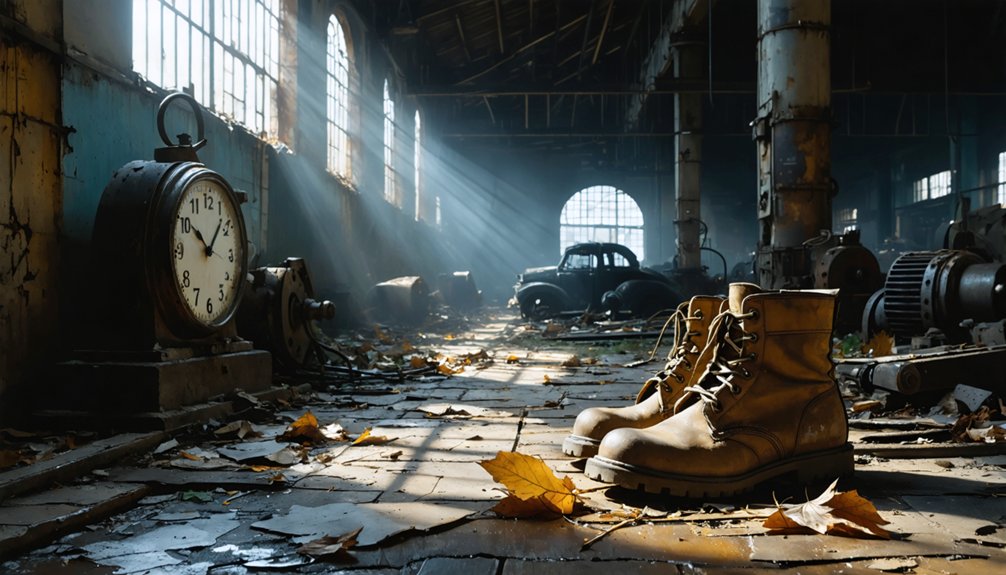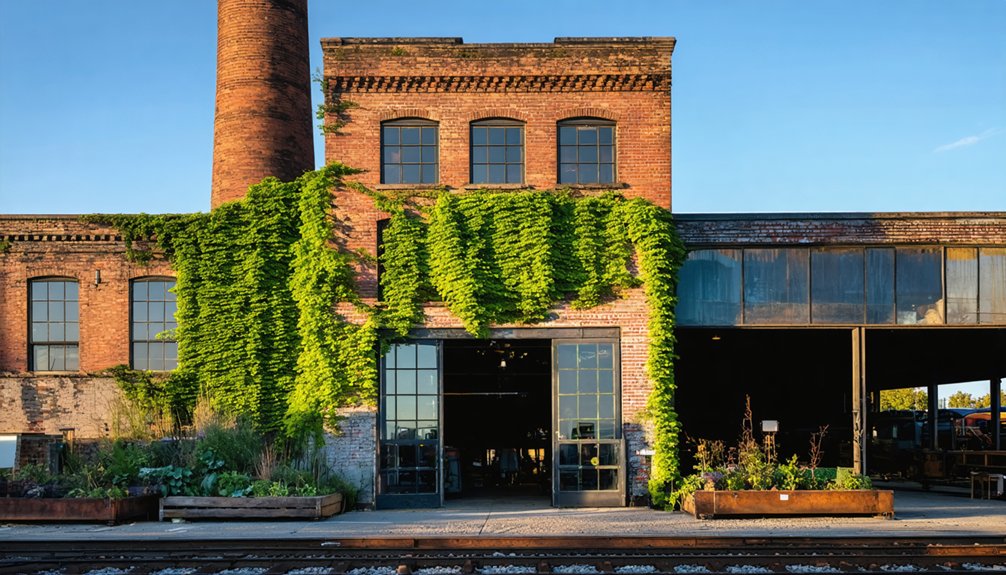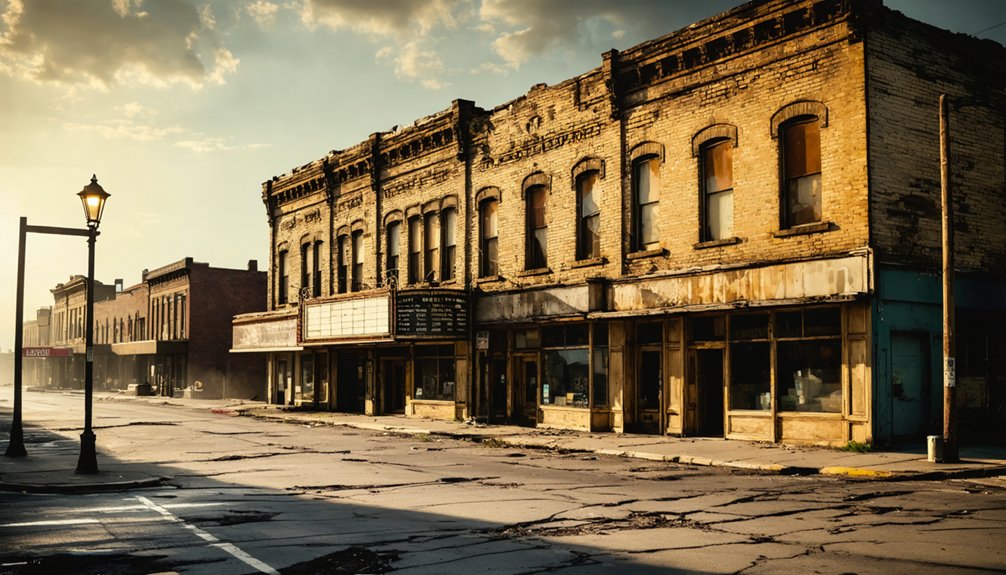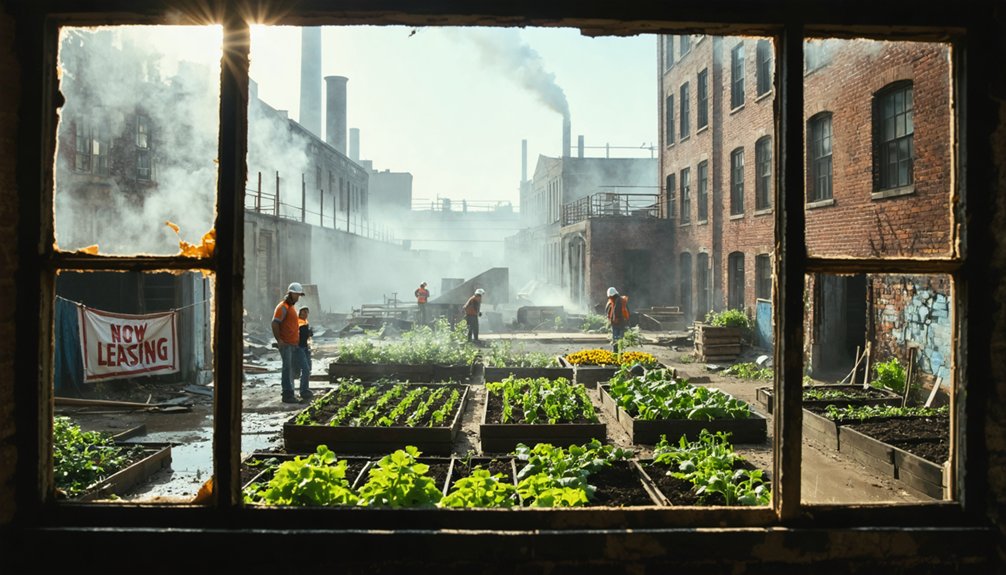Rust Belt ghost towns stand as stark reminders of America’s industrial past. You’ll find these abandoned communities scattered throughout the Great Lakes region, victims of globalization, policy failures, and technological shifts that began in the 1970s. Once-thriving manufacturing centers now feature decaying factories, empty homes, and fractured social networks. Despite environmental contamination and economic devastation, some cities like Pittsburgh have successfully transformed, offering valuable lessons in resilience and adaptation for struggling post-industrial landscapes.
Key Takeaways
- Abandoned factories and boarded windows symbolize economic collapse following the manufacturing exodus from Great Lakes cities.
- Many Rust Belt towns lost over 50% of their population, leaving behind fractured communities and urban decay.
- Environmental contamination from shuttered factories created health hazards and brownfields requiring extensive remediation.
- Former industrial powerhouses like Detroit and Cleveland experienced dramatic population decline when manufacturing jobs disappeared.
- Some ghost towns now serve as historical landmarks, preserving the cultural legacy of America’s industrial golden era.
The Golden Era: Pre-War Manufacturing Powerhouses

Before America’s industrial landscape transformed into what’s understood today, the Rust Belt region flourished as the nation’s manufacturing heartland, establishing itself as the backbone of American economic might throughout the early to mid-20th century.
You’d have witnessed an unprecedented era of industrial innovation centered around the Great Lakes, where steel mills and auto plants dominated cityscapes. The strategic location allowed for efficient transportation of coal and iron ore via waterways, while extensive rail networks distributed finished goods nationwide.
This manufacturing juggernaut peaked in 1953, comprising the largest percentage of American GDP in history. Labor movements gained momentum as immigrants from Eastern Europe and African Americans during the Great Migration formed the workforce backbone, creating powerful unions that established middle-class prosperity in Pittsburgh, Detroit, Cleveland, and Buffalo. Contrary to popular belief, US manufacturing has maintained higher productivity since World War II despite employment shifts. Historical infrastructure developments like the Erie Canal in 1825 played a crucial role in the initial growth and economic success of the region.
The Perfect Storm: Factors Behind Rust Belt Collapse
You’ll find that globalization delivered the most devastating impact to Rust Belt communities through a relentless flood of cheaper foreign imports and capital flight to regions with lower labor costs.
Government policies exacerbated this decline by removing trade barriers and negotiating agreements like NAFTA without adequate adjustment support for affected workers and communities.
The combination of strong dollar policies in the 1980s and insufficient investment in education and workforce development left Rust Belt cities particularly vulnerable to the structural economic changes that followed. Many industrial operations suffered from technological complacency, failing to modernize machinery and production methods after enjoying decades of post-World War II economic dominance.
Before 1980, these regions enjoyed market dominance with shares as high as 90% in key industries like auto, steel, and rubber, creating little incentive to innovate or respond to changing market conditions.
Globalization’s Fatal Blow
While many factors contributed to the decline of manufacturing in America’s heartland, globalization delivered the most decisive blow to Rust Belt communities during the latter half of the 20th century.
You witnessed your region’s manufacturing decline accelerate as companies embraced global supply networks, relocating factories to countries with substantially lower labor costs.
The evidence is stark: between 1969 and 1996, manufacturing employment plummeted by 32.9%, while the Rust Belt’s share of aggregate employment dropped from 43% to 33% over five decades.
Foreign competition, particularly from Germany and Japan in steel production, undercut domestic industries. Trade liberalization policies opened floodgates for cheaper imports, while outsourcing hollowed out local economies.
Technological advancement and increasing automation further reduced the demand for manual labor in traditional manufacturing sectors.
Your communities felt this transformation most acutely as factory closures cascaded throughout the region, forever altering the economic landscape of America’s industrial core. Unlike Germany where many manufacturing hubs achieved full recovery, the US exhibited particularly poor employment recovery outcomes, especially in Rust Belt communities.
Government Policy Failures
As the industrial machinery of America’s heartland ground to a halt, government policy failures emerged as a decisive factor that transformed manageable economic challenges into catastrophic collapse.
You witnessed Reagan’s laissez-faire approach slash significant federal aid while deregulation exposed vulnerable industries to ruthless market forces.
This government neglect manifested in trade policies like NAFTA that accelerated manufacturing exodus without supportive systems.
When corruption infected municipal leadership, redevelopment efforts stalled amid crumbling infrastructure.
Policy missteps extended to education, where workforce retraining initiatives moved too slowly to bridge widening skill gaps. The aging workforce issue further compounded economic diversification challenges as younger generations left the region in search of opportunities elsewhere.
The perfect storm intensified as urban policies privileged suburban expansion over city revitalization.
Interstate highways carved through neighborhoods while local governments, crippled by evaporating tax bases, slashed essential services.
What might’ve been gradual economic evolution became instead a traumatic amputation of the American industrial core.
The protectionist measures implemented from the 1950s through the 1980s ultimately backfired when industries failed to innovate due to lack of competitive pressure.
Population Exodus: The Human Cost of Deindustrialization

The dramatic outflow of residents from Rust Belt cities since the 1970s represents one of the most profound demographic shifts in modern American history.
You’ve witnessed cities like Detroit and Cleveland lose nearly half their populations—Detroit falling from 1.5 million to 834,000 residents by 2006, Cleveland from 751,000 to 406,000.
This population displacement devastated more than just numbers; it fractured the economic and social fabric of communities. When workers migrated seeking employment elsewhere, they took with them not only their economic contributions but also essential social capital.
Despite this exodus, you’ll find examples of community resilience, particularly in cities like Pittsburgh, where higher concentrations of college-educated residents helped pivot toward new industries. Research shows only 17% of US manufacturing hubs recovered their previous employment levels, lagging far behind their European counterparts.
The human cost extends beyond economics—with increased mortality rates and social breakdown becoming hallmarks of the most affected areas. Abandoned properties and factories created urban decay that continues to plague these communities decades after initial plant closures.
Empty Streets: The Visual Landscape of Abandonment
Once vibrant thoroughfares with bustling commercial districts, Rust Belt ghost towns now present visitors with haunting panoramas of emptiness where silence has replaced the rhythmic cadence of industrial progress.
As you walk along cracked empty sidewalks, you’ll notice the stark juxtaposition of architectural decay against persistent nature—wildflowers pushing through cement and trees reclaiming factory lots.
The visual landscape offers profound testimony to economic abandonment: boarded windows stare like vacant eyes across deserted streets where silent echoes of past activity linger.
Downtown plazas stand neglected, their benches weathering beneath snow and rain. These spaces challenge conventional notions of urban aesthetics, inviting contemplative engagement with the post-industrial environment.
In this stillness, you witness both the devastating human cost of deindustrialization and nature’s persistent cycle of renewal amid human withdrawal.
From Factory Floor to Foreclosure: Housing Market Implosion

As you drive through Rust Belt neighborhoods today, you’ll witness the aftermath of industrial collapse manifesting in abandoned homes that stand as monuments to foreclosed dreams.
These neighborhoods face the painful dilemma of whether to demolish structurally compromised properties—often at costs exceeding $15,000 per structure—or preserve historically significant housing stock despite limited resources.
The juxtaposition of vacant lots where homes once stood against deteriorating century-old structures encapsulates the region’s struggle to reimagine its built environment amid persistent economic challenges.
Abandoned Dreams Everywhere
Devastation swept through Rust Belt communities as the 2008 financial crisis triggered one of the most catastrophic housing market collapses in American history.
You’d find entire neighborhoods hollowed out, with abandoned properties stretching block after block. The data reveals staggering vacancy rates exceeding 15% in many areas, with hypervacancy persisting well into the 2010s despite national recovery trends.
Cities like Detroit and Cleveland lost nearly half their populations over four decades, leaving community revival efforts struggling against overwhelming odds.
- Foreclosed homes with boarded windows and collapsing roofs
- Empty streets where children once played, now overgrown with weeds
- Abandoned schools standing as eerie monuments to departed families
- Vast urban prairies where neighborhoods once thrived
- Crumbling infrastructure surrounding isolated occupied homes
Demolition vs. Preservation
When confronted with tens of thousands of deteriorating structures, Rust Belt municipalities face a critical dilemma between demolishing abandoned properties and preserving architectural heritage.
The data reveals complex trade-offs: demolition reduces crime by 6.7% for violent offenses and 9.7% for property crimes, while increasing nearby property values by up to 4.2%.
Yet these improvements come at substantial costs—Detroit’s $250 million program removed just 20,800 properties, highlighting demolition challenges including limited return on investment.
Meanwhile, preservation benefits remain largely untested. By the time cities gain control of properties, most have been stripped of valuable materials during lengthy foreclosure processes.
You’re witnessing a pragmatic calculation: immediate safety improvements versus architectural heritage, with neither option addressing the fundamental economic challenges that created these ghost towns in the first place.
Environmental Scars: Ecological Legacy of Industry
The industrial titans that once dominated the Rust Belt landscape have left behind more than crumbling factories and economic hardship—they’ve imprinted a toxic legacy directly into the region’s ecological fabric.
Your community’s soil, water, and air continue to harbor heavy metals, asbestos, and “forever” chemicals from decades of manufacturing. This industrial contamination creates stark health disparities, particularly in neighborhoods where schools and homes occupy former factory sites.
Environmental justice demands soil remediation and ecological restoration to transform brownfields into valuable green spaces.
- Rusted factory pipes leaking orange sludge into once-pristine rivers
- Children playing in vacant lots unaware of lead contamination below
- Former steelworks with crumbling asbestos insulation blowing in the wind
- Community gardens sprouting through concrete, reclaiming industrial sites
- Abandoned coal mines leaching acid into groundwater systems
Scattered Communities: Social Fabric Unraveled

Beyond the environmental degradation left by industrial collapse, a profound human exodus has reshaped Rust Belt communities into fragmented landscapes of absence and isolation.
You’ll find the social fabric torn most severely in neighborhoods with initially low housing prices, where population losses exceeded 50% in hundreds of census tracts across 49 cities. As residents fled, they took with them the connective tissue of community life.
In their wake, community fragmentation accelerated—banks, supermarkets, and clothing stores shuttered. The void filled with rising crime rates and poverty, with Johnstown’s poverty rate reaching 35% by 2017.
Social cohesion collapsed disproportionately in historically Black neighborhoods, where abandonment concentrated most intensely. The pattern reveals itself starkly in cities like St. Louis and Buffalo, where vacant lots map the geography of racial inequality.
Beyond the Ruins: Stories of Adaptation and Resilience
Despite decades of economic devastation and population exodus, many Rust Belt communities have engineered remarkable comebacks through strategic adaptation and determined resilience.
Through resilience storytelling and adaptive reuse strategies, these cities transformed abandoned industrial complexes into vibrant mixed-use spaces while preserving architectural heritage.
You’ll find waterfront areas once dominated by factories now serving as recreational destinations, attracting young professionals seeking affordable alternatives to coastal markets.
- Pittsburgh’s metamorphosis from steel titan to healthcare and technology hub
- Detroit achieving budget surpluses within a decade of bankruptcy
- Michigan Central Station’s revival from vacant ruin to functional community asset
- Artistic communities flourishing in converted industrial spaces
- Former manufacturing centers now hosting green spaces that improve public health outcomes
These transformations demonstrate how economic diversification and strategic pivoting can revitalize communities previously written off as obsolete.
Reimagining the Landscape: Modern Transformation Efforts

Modern transformation efforts in Rust Belt ghost towns have transcended mere adaptation to encompass extensive landscape reimagining. You’ll find that former industrial centers like Pittsburgh have pivoted from steel manufacturing to robotics and AI startups, creating technological ecosystems where smokestacks once dominated.
This cultural resurgence manifests through creative entrepreneurship in places like Jerome, Arizona, where galleries now occupy historic mining structures, serving dual purposes of preservation and artistic expression. You’re witnessing history and innovation coalesce when entrepreneurs transform weathered buildings into vibrant cultural hubs.
Communities have embraced inclusive development approaches—Marion’s Founders Park remains accessible throughout construction, while tiny home initiatives address housing needs.
These transformations reflect a fundamental shift: successful revitalization doesn’t erase history but rather integrates it into forward-thinking, diversified economies that appeal to freedom-seeking residents and visitors alike.
Frequently Asked Questions
Why Did Foreign Competition Affect Rust Belt Industries More Than Others?
You’ve suffered more from foreign competition because your Rust Belt industries lacked industrial innovation incentives, faced innovation taxes from unions, and were already weakened by high labor costs when globalization intensified.
How Did Racial Demographics Change During Rust Belt Abandonment?
While white residents fled to suburbs, Black populations concentrated in urban centers, deepening racial segregation. You’ll notice these demographic shifts correlated more with Black Great Migration patterns than with industrial decline alone.
What Role Did Labor Unions Play in Industrial Decline?
You’ll find union influence contributed greatly to industrial decline through adversarial labor relations, frequent strikes, and rigid work rules that reduced productivity while their economic power deterred investment in Rust Belt manufacturing.
Which Rust Belt Cities Successfully Transitioned to New Economic Models?
Like phoenixes rising from industrial ashes, you’ll find Pittsburgh, Columbus, Minneapolis, and Cleveland have successfully transformed through adaptive reuse of manufacturing infrastructure and urban revitalization focused on healthcare, technology, education, and innovative entrepreneurship.
Did Government Intervention Programs Help or Harm Recovery Efforts?
Government policies both helped and harmed recovery strategies. You’ll find that funding limitations, fiscal austerity measures, and lack of thorough vision often undermined positive interventions like brownfield remediation and neighborhood stabilization programs.
References
- https://www.cato.org/blog/economic-mobility-not-manufacturing-decline-real-rust-belt-story
- https://allthatsinteresting.com/rust-belt
- https://schoolofcities.utoronto.ca/neighbourhood-abandonment-in-the-american-rust-belt/
- https://www.industryweek.com/talent/article/22028380/the-abandonment-of-small-cities-in-the-rust-belt
- https://www.businessinsider.com/vintage-photos-us-small-towns
- https://www.youtube.com/watch?v=HZFw7MZFycU
- https://www.lovemoney.com/gallerylist/86648/americas-empty-ghost-towns-and-why-theyre-abandoned-today
- https://en.wikipedia.org/wiki/Rust_Belt
- https://www.britannica.com/place/Rust-Belt
- https://www.loveexploring.com/gallerylist/127789/then-and-now-us-rust-belt-cities-that-bounced-back



